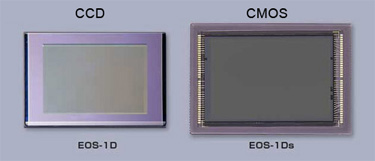Two main categories of sensors
Two different technologies are present on the market: the CCD and the CMOS. Most of the digital cameras are using CCD sensore like Sony, Nikon and Olympus. Only Canon and Kodak, use CMOS sensors for their high end DSLR and digital backs. The two technologies will be described.
 |
Figure 3: Comparison between the CCD sensor of the Canon 1D and the CMOS sensor of the canon 1Ds. |
The CCD
The Charged Couple Devices (CCD) is the most common type of sensor used in almost any digital marketed camera (i.e., Nikon, Fuji, Olypmus, Konica-Minolta). These sensor have been optimized for imaging applications for more than 30 years. CCDs require a special construction and the photsites are arranged in row and columns, since the data output is sequential (figure 3) and with a high uniformity (meaning that the pixels have to be read one after one in a very reliable timing). To read and analyze the information (the light resulting from the exposure), the process has to be perfomed on separate chips. The ADC converter will have to be on separate chip, like the clocking device and the signal amplifier. Since your need several chips to read and convert into digital signals the information contained on the sensor, a CCD camera is power and space consuming. On the other hand, this allow the CCD sensor to have a very high signal to noise ratio (S/N) and an excellent dynamic range.
 |
Figure 3: the pixels from a CCD sensor are transported down the columns, row by row and amplified on a separate chip. The amplification is performed on a separate chip.
The light is collected over the sensor simultaneously, but only once the light has been shut off. |